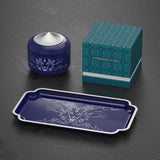

Ascend the Forbidden Hill

A hilltop palace overlooks the city.
On a clear day in the year 1386, Paduka Sri Maharaja could look down from his palace onto the bustling city that he rules, the source of his fabulous wealth. The sight would have impressed even his great ancestor Rajah Chulan, who had travelled to South East Asia from an ancient Indian Kingdom, married a sea goddess and fathered a line of kings. Within the high walls of the city, traders and craftsmen from far-off India and Vietnam, Sri Lanka and Indonesia, mingle with Chinese and Malay artisans to form a cultural melting pot of trade, art and design, whose reputation has spread across the whole of Asia.

Paduka's illustrious predecessors, including Sang Nila Utama, the first ruler of the Kingdom of Singapura, are buried in the brick temple below his palace and the mighty presence of their spirits ensures that ordinary citizens dare not set foot on any part of the hill unless summoned. For seven hundred years its name lingers on… Bukit Larangan, the Forbidden Hill.
The Maharaja’s throne room is the highest building on the sacred ground and itself a work of art. Great wooden pillars support an intricately carved and painted roof, while shimmering curtains of silk in the brilliant yellow of royalty can be raised or lowered to protect him from sun and breeze. A brick-lined path leads down to the other buildings of the palace, whose doorways are flanked by stone pillars carved with the faces of guardian gods and demons.

The works of great masters surround the palace.
At the foot of the Forbidden Hill, paths wind through formal gardens busy with butterflies. Birds sing in groves of fruit trees where gardeners pick rambutan, pomelo, durian, duku and jackfruit for the royal household.
In the middle ground, between the gardens and the palace, smoke rises from braziers and kilns. Here, the most famous artisans of Asia and beyond exercise their skills, combining their talents to make objects of beauty to adorn the princes and princesses of the palace. A painter of porcelain from China might exchange designs with an expert in lacquer ware from Vietnam. Or a goldsmith from Java might turn his skill to the intricate Islamic designs shown to him by an artist from Persia.

Across the hill, lies another treasure.
Residents of the Palace might hear squeals and laughter echoing from the eastern side of the hill, where a clear spring has been diverted to fill a stone-lined pool, twenty metres square set amid discreet red brick walls.
Servant girls scatter frangipani blooms on the water, in which the ladies of the palace play games and bathe the limbs that are adorned with the precious rings, necklaces and bangles being created for them in the Palace workshops. This most forbidden of all places was known as Pancur Larangan, the Forbidden Spring.
This whole extraordinary complex flourished seven centuries before it became known to the world as Singapore. Its unique flowering of creative achievement, a totally original blend of artistic traditions from all over South East Asia, has been compared by scholars to the European Renaissance, and is the inspiration for the collection we call Forbidden Hill.










































